The piece of the month of August 2019
THE MISSING ALTARPIECE OF SAN ESTEBAN OF THE CHURCH OF THE ASSUMPTION OF CASCANTE
María Josefa Tarifa Castilla
University of Zaragoza
The parish church of Nuestra Señora de la Asunción in Cascante was one of the great stone temples erected in Navarre during the 16th century, begun by Juan López de Goroa (1527-1532) and continued by the Guipuzcoan stonemasons Luis de Garmendia and Antón de Beñarán (1534-1549), Juan de San Juan (1550-1558), the Cascantino Martín de Arriba (1583-1585) and Miguel de Múxica, among others, with some architectural interventions still pending that would be completed over time. The building was adorned with an important artistic decoration, according to the fashions and tastes of each moment, among which the main altarpiece (1592-1601) stood out, fruit of the partnership between Pedro González de San Pedro and Ambrosio de Bengoechea, disciples of the Romanist sculptor Juan de Anchieta ( A ), with the assembly corresponding to Domingo de Bidarte.
Unfortunately, the church disappeared for the most part as a result of the dreadful fire it suffered on the night of May 14-15, 1940, leaving only part of the perimeter walls, the southern side doorway, the Santo Cristo chapel, the sacristy and the baroque bell tower. A few years later the building was reconstructed, maintaining the original typology of a hall plan with three naves, the central one larger than the lateral ones, articulated in five bays (Fig. 1). In this incident, almost all of the works of art located inside, such as altarpieces, paintings, sculptures, etc., were also destroyed, which meant a serious loss for the artistic heritage, not only of Cascantino, but also of Navarre.
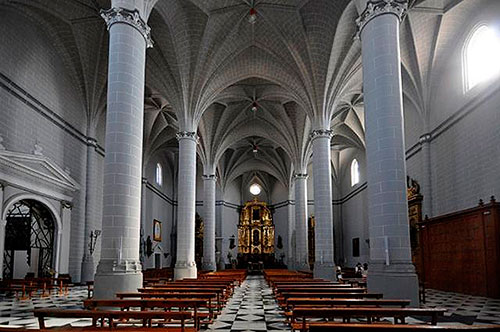
Parish Church of Nuestra Señora de la Asunción in Cascante.
Photo: Mª Josefa Tarifa.
From one of the existing altarpieces in the church were saved the fragments of two panels with scenes in relief of the life of a saint, which now hang on one of the walls of the baroque sacristy. These blank, unpolychromed reliefs were included in the Catalog Monumental de Navarra in the volume dedicated to the merindad of Tudela (1980), located at that time in the entrance to the baroque chapel of Santo Cristo in the parish church of Cascantina, with the theme of the Stoning of St. Stephen (107 x cm), in one case, and the Body of St. Stephen carried by the deacons (107 x ), in the other. The authors of the Catalog identified these reliefs as parts of the disappeared Romanesque collateral altarpiece that Pedro González de San Pedro and Ambrosio de Bengoechea had contracted in 1593.
data The work of research that we have carried out on these two reliefs has made it possible to shed new light on their chronology and provenance. In the first place, the enquiry of photographs of the temple, taken immediately after the fire of 1940, has made it possible to determine the place that these reliefs occupied as part of the stories that made up the altarpiece of St. Stephen, attached to one of the sides of the church, probably in the right nave. Secondly, the location in the file of Protocols of Tudela of the hitherto unpublished architectural contract of said altarpiece has revealed the authorship of the master who undertook it, as well as the conditions under which the masonry was executed, which was carried out to the letter, as can be verified by reading the clauses of the aforementioned notarial protocol .
On April 7, 1624, Juan de Vea, racionero, Jerónimo López de Ribaforada, Pedro Martín de Nicasio and Sebastián de Falces, jurors of the town of Cascante and primicieros of the parish church, made an agreement in that town with Juan de Gurrea († 1644), a resident of Tudela, who undertook to carry out the architecture and assembly of the collateral altarpiece of Saint Stephen. This master, a native of the town of Ejea (Zaragoza), was one of the most outstanding artisans who worked in the Ribera de Navarra in the first decades of the 17th century, being the initiator of a dynasty of altarpieces that stood out throughout the sixteenth century, as Fernández Gracia has studied, among whose production is the execution of the disappeared altarpiece of the Virgen del Romero de Cascante, contracted in 1626. Gurrea was also documented a few years ago working in this same locality, specifically collaborating in the execution of the masonry of the main altarpiece of the church of the convent of Minim de Nuestra Señora de la Victoria, at least from April 1623.
Regarding the altarpiece of St. Stephen of the Cascantina parish, Gurrea undertook to undertake it in the deadline of a year and a half from the signature of the present deed, that is, for October 1625, and for the value of 300 ducats, a work that would be carried out from agreement to the capitals provided by the promoters. In the first place, the altarpiece would be executed taking as "traça y model" the collateral altarpiece of Saint Anne existing in the same temple, both with regard to the design of its masonry as well as the parts worked with pine or walnut, as specified in each of the clauses.
Thus, the altarpiece of St. Stephen would have a pedestal of walnut, formed by base and sotabasa, on which would be arranged the titular St. Stephen in "his round box", ie, inside a curved niche formed by a semicircular arch on pilasters, plus "two stories of half reliebe with their frames of moldings for decoration", therefore, with scenes of half relief framed by a molded framework . Four Ionic columns topped with architrave, frieze and cornice would also be installed on the pedestal, the frieze being made of pine and the other two parts of walnut.
This structure would be followed by the second body, also composed of a flat pedestal, on which would rest four Corinthian columns with their "traspilares and a San Lorenço in a round box and the stories with their plinths of moldings for adornment", over which would run an entablature with the architrave and the cornice of walnut, and the frieze of pine, therefore, maintaining the architectural outline of the lower body. Finally, the attic would consist of a single central box, flanked by two stipes, which would house a Calvary composed of the figures of Christ, the Virgin Mary and St. John, all topped by an entablature, triangular pediment and pyramids.
In final, Gurrea would only be position to undertake the architectural structure of the piece and its assembly, since as specified in the contract "for the said altarpiece he would be given the figures and stories that were said and the rest until they were settled, to be done at his own expense".
The altarpiece was faithfully executed from agreement to this condition, as we can verify thanks to the only photograph we have located of this work, taken immediately after the terrible fire that devastated the church of Cascante in 1940, which caused serious damage to the piece (Fig. 2). The altarpiece was composed of two sections that rested on a plain pedestal, subdivided into three sections articulated by columns -Ionic in the first section and Corinthian in the second-, followed by the attic, whose structure is not visible in the photo, but there are two sculptures -probably the carvings of the Virgin Mary and Saint John that would make up the Calvary described in the conditions of the work-, which would have been topped by a triangular pediment and pyramids. The side streets were formed by rectangular boxes with the framework decorated with smooth moldings, which housed scenes in relief, while the central street described semicircular niches inside which were arranged round sculptures.
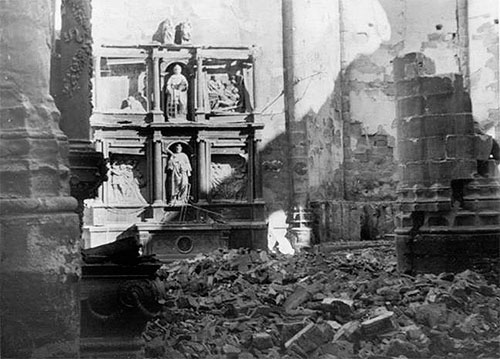
View of the church of Cascante and the altarpiece of San Esteban after the fire of 1940.
Photo published in J. M. Ruiz, Cascante, historia y recuerdos en imágenes,
Cascante, 2005.
Therefore, it was a classicist altarpiece, prevailing in the first half of the 17th century, with a straight plan, in which a balance between horizontals and verticals was sought and in which the influence of the thriving Romanist school that lasted throughout the first decades of the 17th century in Navarre could still be perceived in its figurative program. Of the four reliefs that originally composed the altarpiece, only the fragments of two of them have come down to us, to which we have alluded previously, arranged in the lateral streets of the first body, with scenes from the life of the titular Saint Stephen, who was condemned to stoning after infuriating the Jewish priests of the Sanhedrin. The left side of the first body contains the scene of the martyrdom of St. Stephen, kneeling, with his hands joined in prayer and his gaze directed towards heaven, behind him were standing male figures in various postures, representing the crowd that was about to stone him on the outskirts of the city of Jerusalem. The part of the preserved relief sample shows only the upper torso of St. Stephen, with an elaborate curly hair, and behind him two executioners, with powerful and marked anatomies, holding in their hands the stones with which they are going to kill the saint (Figs. 3 and 4).
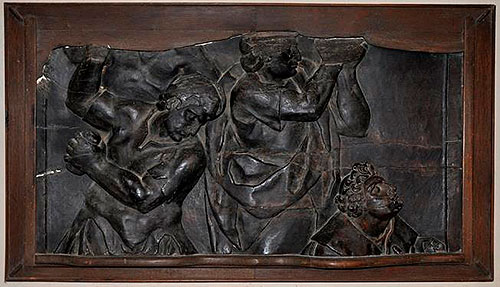
Relief of the stoning of St. Stephen.
Photo: Mª Josefa Tarifa.
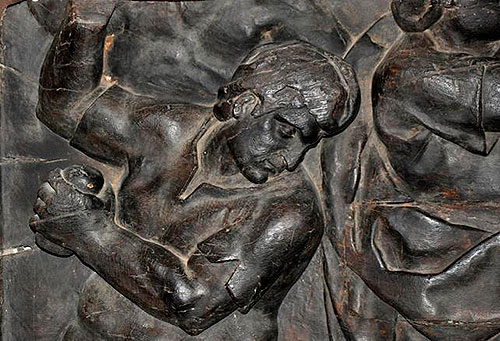
Detail of the relief of the stoning of St. Stephen.
Photo: Mª Josefa Tarifa.
For its part, the right side of the first body of the altarpiece showed the relief with the transfer of the body of St. Stephen carried by the deacons, of which the fragment corresponding to the central area of the panel has been preserved, mostly occupied by the diagonal that describes the corpse of the lying martyr, hidden under the vestment, which is held by other deacons, as revealed by the tonsure of his curly hair (Figs. 5 and 6).

Relief of the transfer of the body of St. Stephen by the deacons.
Photo: Mª Josefa Tarifa.
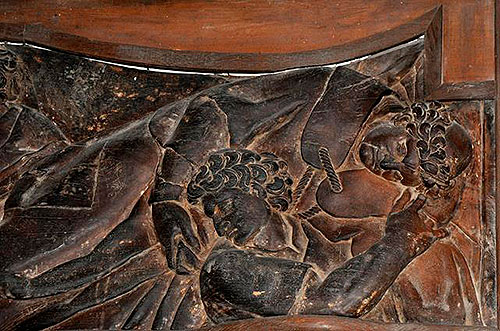
Detail of the relief of the transfer of the body of St. Stephen by the deacons.
Photo: Mª Josefa Tarifa.
On the other hand, no remains of the other two reliefs located in the side streets of the second body of the altarpiece, dedicated to the life of St. Lawrence, such as the scene of martyrdom in which the deacon is roasted naked on a grill placed on a mantle of embers in the right box, have survived.
The authors of the Catalog Monumental de Navarra also located in the parochial dependencies the two Romanesque wood carvings belonging to the altarpiece under study, which as can be seen in the 1940 photograph occupied the central street, that of St. Stephen in the first body, and that of St. Lawrence in the second, sculptures that had suffered serious deterioration in the fire. At present the whereabouts of these two sculptures are unknown, so we have only been able to study them from the photographs collected by the members of Catalog Monumental en Navarra during the realization of the same in the late 1970s.
The figure of St. Stephen (Fig. 7), the main figure of the altarpiece, represents the one who is considered the first Christian martyr according to the New Testament passage(Acts of the Apostles, 6-7), and the first of the seven deacons chosen by the apostles to help in the propagation of the new Christian faith. It is a round sculpture with a full body, volumetric forms, standing, in which the saint appears dressed in the deacon's dalmatic and with the manipule attached to the left wrist on the sleeve of the alb. The head sample the face of a young and beardless man, with his frontal gaze directed to infinity, whose hair carved in locks exhibits the tonsure typical of his clerical Degree . Between his hands he carries the attributes that identify him, holding in his left hand a book Closed -perhaps in allusion to the book of the Gospels, whose custody corresponded to the deacons-, on which are sculpted the stones with which he suffered the torment of stoning, while in his right hand, which rests on his chest, he carried the palm of martyrdom, as can be seen in the photograph of 1940.
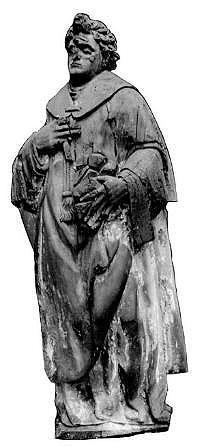
Sculpture of St. Stephen.
Photo: Catalog Monumental de Navarra (1980).
In the case of the sculpture of Saint Lawrence (Fig. 8), sample , the Aragonese saint is effigied with a beardless face and curly chivalry, full-length, standing, wearing the deacon's dalmatic and holding in his hands the handle of the grill on which he was tortured by order of the emperor Decius. The loss of the right forearm does not make it possible to identify the object he was carrying with it, as can be seen in the 1940 photograph.
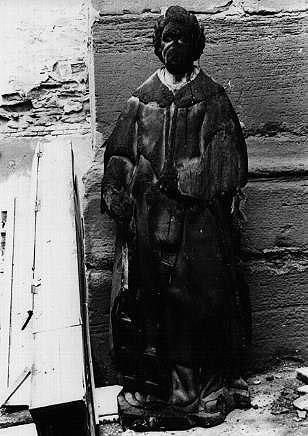
Sculpture of Saint Lawrence.
Photo: Catalog Monumental de Navarra (1980).
SOURCES AND BIBLIOGRAPHY
FERNÁNDEZ GRACIA, R., El retablo barroco en Navarra, Pamplona, Government of Navarra, 2003, pp. 179-187.
FERNÁNDEZ GRACIA, R., "Los géneros escultóricos", in Fernández Gracia, R., Andueza Unanua, P., Azanza López, J. J. and García Gainza, M.ª C., El arte del Barroco en Navarra, Pamplona, Gobierno de Navarra, 2014, p. 179.
GARCÍA GAINZA, M.ª C., HEREDIA MORENO, C., RIVAS CARMONA, J. and ORBE SIVATTE, M., Catalog Monumental de Navarra, I. Merindad de Tudela, Pamplona, Institución Príncipe de Viana, 1980, p. 54.
TARIFA CASTILLA, M.ª J., La arquitectura religiosa del siglo XVI en la merindad de Tudela, Pamplona, Gobierno de Navarra, 2005, pp. 367-383.
TARIFA CASTILLA, M.ª J., El Convento de Nuestra Señora de la Victoria de Cascante, Cascante, association Cultural Amigos de Cascante "VICUS" and Government of Navarra, 2014, pp. 115-117.
RÉAU, L., Iconography of Christian art. Iconography of the saints A-F, volume 2, vol. 3, Barcelona, Ediciones del Serbal, 1997, pp. 459-472.
RÉAU, L., Iconography of Christian Art. Iconografía de los santos G-O, vol. 2, vol. 4, Barcelona, Ediciones del Serbal, 1997, pp. 255-261.
RUIZ, J. M., Cascante, historia y recuerdos en imágenes, Cascante, 2005, p. 137.
